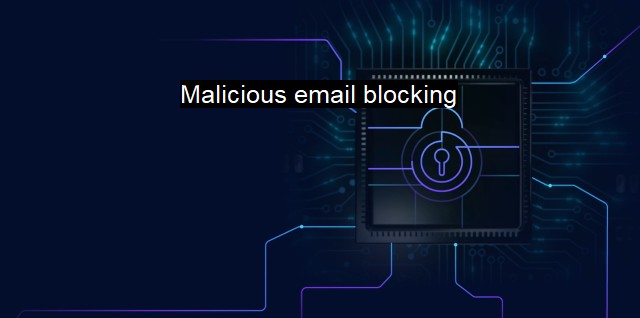What is Malicious email blocking?
Protecting Sensitive Information in the Digital Age: The Power of Malicious Email Blocking
"Malicious email blocking" is a critical aspect of cybersecurity and antivirus protection measures that are used to protect internet users from harmful or unwanted digital communication. a malicious email represents any email that is designed to inflict damage on the recipient in some way. It is typically used as a tool by cybercriminals to infiltrate systems, access sensitive data and manipulate the users in doing something that compromises the system's security.Malicious emails often come in different forms, with phishing emails being one of the most common. These emails appear legitimate but contain infected attachments, links to malicious websites, or are deceptively designed to trick recipients into providing sensitive information such as passwords or credit card numbers.
Other forms of malicious emails include spam emails, which, although sometimes annoying and not threatening, some contain malware, malicious software intended to damage or disable computers and computer systems. Email spoofing is another form, where the sender's address is falsified to appear as if it comes from someone the recipient knows and trusts, also known as deceptive phishing.
Malicious email blocking in cybersecurity refers to the mechanisms and strategies designed and used to effectively fend off these harmful emails and ensure user safety. This practice is of critical significance to both personal users and business entities, especially considering the growing technological dependence in modern-day processes and transactions. Besides physical damage and theft of data, these emails can affect the reputation and integrity of businesses, derail operations, and cripple finances.
Different antivirus software applications employ various techniques to block malicious emails. One of the typical methods is through heuristic analysis, a technique in which the software scrutinizes the email's characteristics, contents and the sender's details to determine its threat level. Any email considered a risk is then blocked or moved to a spam or junk folder.
Another approach is signature-based detection, where the software references the content of the email against a database of known threat signatures. If the software identifies a pattern, sequence or a known malware signature, it blocks the email.
Some advanced cybersecurity systems employ machine learning and artificial intelligence technologies to effectively block malicious emails. These sophisticated tools use past patterns and behaviors to learn and predict different types of threats. They can swiftly detect new and evolving threats and automatically restrict them, reducing the chance of damage significantly.
An essential aspect of blocking malicious emails is regularly updating the protective software. As cyber threats evolve and become sophisticated, cybersecurity providers need to adapt with agile and up-to-date solutions. They regularly release updates to tackle current and emergent threats; therefore, it's imperative to keep one's antivirus software current.
Taking personal responsibility for the safety of the system you're using is another crucial factor. This involves implementing best practices like not opening suspicious emails, clicking on unverified links or attachments, and refraining from revealing sensitive information in dubious circumstances. By smartly combining antivirus software's protective capabilities with these safe practices, one can significantly decrease the likelihood of being a victim of a malicious email attack.
Malicious email blocking is an essential process in today's digital landscape, aimed at stopping harmful emails from reaching users. Employing reliable, up-to-date antivirus applications and practicing safe email habits can help individuals and companies, alike, maintain their digital safety and integrity. Despite the threats and challenges presented in the turbulent world of cybercrime, armed with the understanding and appropriate counteraction tools, everyone can confidently navigate the cyber waters with malice and deception lurking beneath.

Malicious email blocking FAQs
What is malicious email blocking?
Malicious email blocking is a cybersecurity feature that detects and prevents unwanted and potentially harmful emails from reaching your inbox. It involves using antivirus software and other security measures to identify and block emails that contain malware, phishing attempts, or other forms of cyber threats.How does malicious email blocking work?
Malicious email blocking works by analyzing the content and attachments of incoming emails in real-time. The antivirus software uses behavioral and signature-based detection methods to identify and block emails that are deemed malicious. It can also use artificial intelligence and machine learning algorithms to improve its threat detection accuracy.Why is malicious email blocking important for cybersecurity?
Malicious email blocking is crucial for preventing cyber attacks such as phishing, ransomware, and malware infections. Cybercriminals often use email as a primary method to deliver their malicious payloads. By blocking malicious emails, cybersecurity measures can significantly reduce the risk of a successful cyber attack.Can users configure their malicious email blocking settings?
Yes, in most cases, the user can configure their malicious email blocking settings to suit their needs. For example, they may choose to block all emails from specific senders or domains, add specific keywords to block emails containing them, or choose how to handle emails that are marked as suspicious. However, it is essential to ensure that the settings are appropriately configured to avoid blocking legitimate emails from reaching the inbox.| | A | | | B | | | C | | | D | | | E | | | F | | | G | | | H | | | I | | | J | | | K | | | L | | | M | |
| | N | | | O | | | P | | | Q | | | R | | | S | | | T | | | U | | | V | | | W | | | X | | | Y | | | Z | |
| | 1 | | | 2 | | | 3 | | | 4 | | | 7 | | | 8 | | |||||||